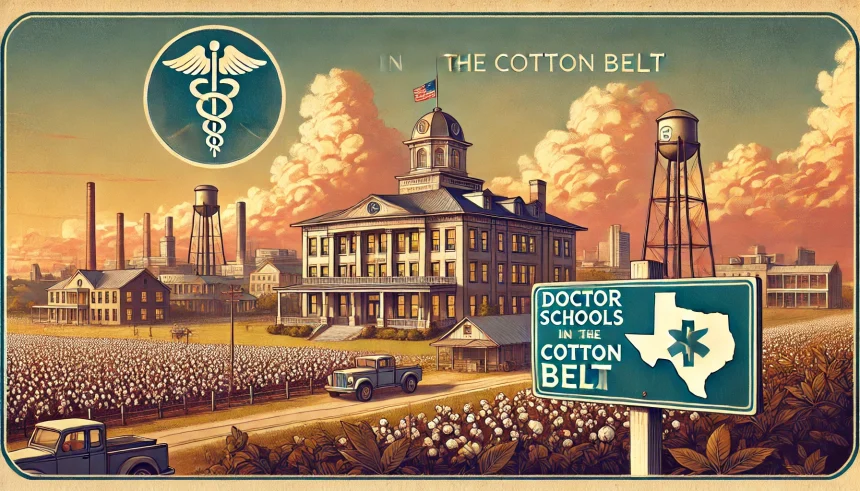The Cotton Belt refers to the southern region of the United States, historically known for its cotton production. This area includes states like Texas, Georgia, Alabama, Louisiana, Tennessee, and Mississippi. Over time, the region has also become home to many well-known medical schools.
Medical education in the Cotton Belt has grown significantly, providing excellent training facilities and research opportunities. Students can choose from various programs, including allopathic (MD) and osteopathic (DO) schools. Many institutions also focus on serving rural and underserved communities.
Doctor schools in the Cotton Belt offer advanced training in different medical fields. Students receive hands-on experience in hospitals, research centers, and clinics. Some universities even provide specialized programs to prepare students for specific healthcare challenges in the region.
The region is also home to historically Black medical schools, which have played a vital role in training African American doctors. These institutions have contributed significantly to improving healthcare access in underserved populations.
Studying in the Cotton Belt offers diverse learning experiences, from urban medical centers to rural clinics. This mix helps students gain exposure to different patient populations, preparing them for a broad range of medical careers.
History of Medical Education in the Cotton Belt
Medical education in the Cotton Belt dates back to the 19th century. Early institutions focused on basic medical training, often without modern resources. Over time, these schools expanded, adopting advanced medical research and technology.
One of the most significant developments was the establishment of historically Black medical colleges. Schools like Meharry Medical College and Morehouse School of Medicine were founded to provide opportunities for African American students. These institutions continue to play a key role in training minority doctors.
During the 20th century, doctor schools in the Cotton Belt grew in number and reputation. Many universities invested in modern medical facilities, attracting students from across the country. Research centers and teaching hospitals became an essential part of medical education.
Several schools in the region now rank among the best medical programs in the country. Institutions like Baylor College of Medicine and Emory University have gained national recognition for their contributions to medical research and healthcare.
Today, the Cotton Belt offers some of the best medical training programs in the U.S. These schools prepare students to work in diverse healthcare settings, from urban hospitals to rural clinics.
Notable Medical Schools in the Cotton Belt
The Cotton Belt is home to several prestigious medical schools. These institutions provide excellent education, research facilities, and clinical training opportunities.
Texas
- University of Texas Southwestern Medical Center – Known for its advanced research programs.
- Baylor College of Medicine – One of the top-ranked medical schools in the U.S.
- University of Texas Health Science Center – Offers MD and residency training in multiple specialties.
Georgia
- Emory University School of Medicine – Offers strong programs in medical research and patient care.
- Medical College of Georgia – The state’s largest medical school, with a focus on primary care.
Alabama & Louisiana
- University of Alabama at Birmingham School of Medicine – Provides training in both rural and urban healthcare settings.
- Tulane University School of Medicine – A top medical school with strong global health programs.
Tennessee & Mississippi
- Meharry Medical College – A historically Black college with a strong focus on minority healthcare.
- University of Mississippi Medical Center – The state’s only academic medical center, offering multiple specialties.
These schools offer various programs, from traditional MD degrees to specialized research tracks. Many also provide financial aid and scholarships for medical students.
Importance of Historically Black Medical Schools (HBCUs)
Historically Black medical schools play a crucial role in training African American doctors. These institutions were established to provide medical education opportunities that were once denied to Black students.
Meharry Medical College in Tennessee and Morehouse School of Medicine in Georgia are two of the most prominent HBCUs in the Cotton Belt. These schools have produced thousands of healthcare professionals who serve minority and underserved communities.
Many of these institutions focus on primary care, internal medicine, and public health. They aim to address healthcare disparities by training doctors who will work in underserved areas.
HBCU medical schools also contribute to groundbreaking research in diseases that disproportionately affect African Americans. They focus on conditions like hypertension, diabetes, and sickle cell anemia.
These schools continue to play an essential role in healthcare. Their graduates make a significant impact in medical fields across the country.
Osteopathic Medical Schools in the Cotton Belt
Osteopathic medicine (DO) is an alternative path to becoming a doctor. DOs receive similar training as MDs but focus on a more holistic approach to patient care.
The Cotton Belt has several osteopathic medical schools, including:
- Alabama College of Osteopathic Medicine – Offers hands-on training in primary care medicine.
- William Carey University College of Osteopathic Medicine – Focuses on preparing doctors for rural healthcare.
DOs use techniques like osteopathic manipulative treatment (OMT) to help with pain management and mobility issues. They are fully licensed physicians, just like MDs.
Many osteopathic schools in the Cotton Belt emphasize rural medicine. Their programs train doctors to serve in communities with limited healthcare access.
Students who choose this path receive the same residency and specialization opportunities as MDs. The demand for DOs is growing, making it an excellent option for future doctors.
Admission Requirements & Curriculum
Getting into medical school is highly competitive. Students must meet strict admission requirements to qualify for MD or DO programs.
Common Requirements:
- A bachelor’s degree in a relevant field (biology, chemistry, etc.).
- A high MCAT score to demonstrate academic ability.
- Strong letters of recommendation from professors or healthcare professionals.
- Clinical experience, such as volunteering or working in hospitals.
Once admitted, medical students complete a four-year curriculum that includes:
- Basic science courses in anatomy, biochemistry, and physiology.
- Clinical rotations in different specialties like surgery, internal medicine, and pediatrics.
- Research opportunities in medical advancements and public health.
After completing medical school, graduates enter residency programs, where they specialize in their chosen field. Residency length varies depending on the specialty.
Cost & Financial Aid
Medical school is a significant financial investment. Tuition varies between public and private institutions.
- Public medical schools typically cost $30,000 to $50,000 per year.
- Private medical schools can charge $60,000 or more annually.
To help students afford tuition, many schools offer:
- Scholarships based on merit and financial need.
- Federal loans that provide low-interest funding for medical students.
- Loan forgiveness programs for doctors who work in underserved areas.
Many graduates participate in programs like the National Health Service Corps (NHSC), which offers loan repayment in exchange for serving in rural or low-income communities.
Understanding financial aid options can help students reduce debt and manage their education expenses more effectively.
Conclusion
Doctor schools in the Cotton Belt provide excellent training for future healthcare professionals. These institutions offer diverse learning environments, from large research hospitals to small rural clinics.
The region has a mix of traditional MD programs and osteopathic medical schools. Students can choose the best path based on their career goals.
HBCU medical schools continue to make an essential contribution to minority healthcare. They help address disparities by training doctors to serve in underserved areas.
Medical school can be expensive, but scholarships and financial aid options make it more accessible. Programs that support doctors working in rural areas help reduce student loan debt.
Choosing to study in the Cotton Belt offers great opportunities for aspiring doctors. Graduates can build successful medical careers while making a difference in the community.
FAQs
What are the best doctor schools in the Cotton Belt?
Some of the top schools include Baylor College of Medicine, Emory University, and Tulane University, known for research and clinical training.
Are there any historically Black medical schools in the Cotton Belt?
Yes, Meharry Medical College and Morehouse School of Medicine focus on training African American physicians and serving underserved communities.
What is the difference between MD and DO programs in the Cotton Belt?
MD programs focus on traditional medicine, while DO programs emphasize holistic treatment and osteopathic manipulative therapy.
Is financial aid available for medical students in the Cotton Belt?
Yes, scholarships, federal loans, and loan forgiveness programs help students manage tuition costs.
Do medical schools in the Cotton Belt offer rural healthcare training?
Many programs, especially osteopathic schools, specialize in preparing doctors to serve in rural and underserved areas.













